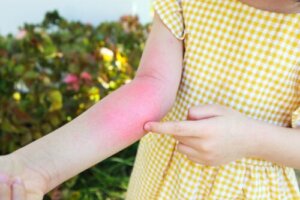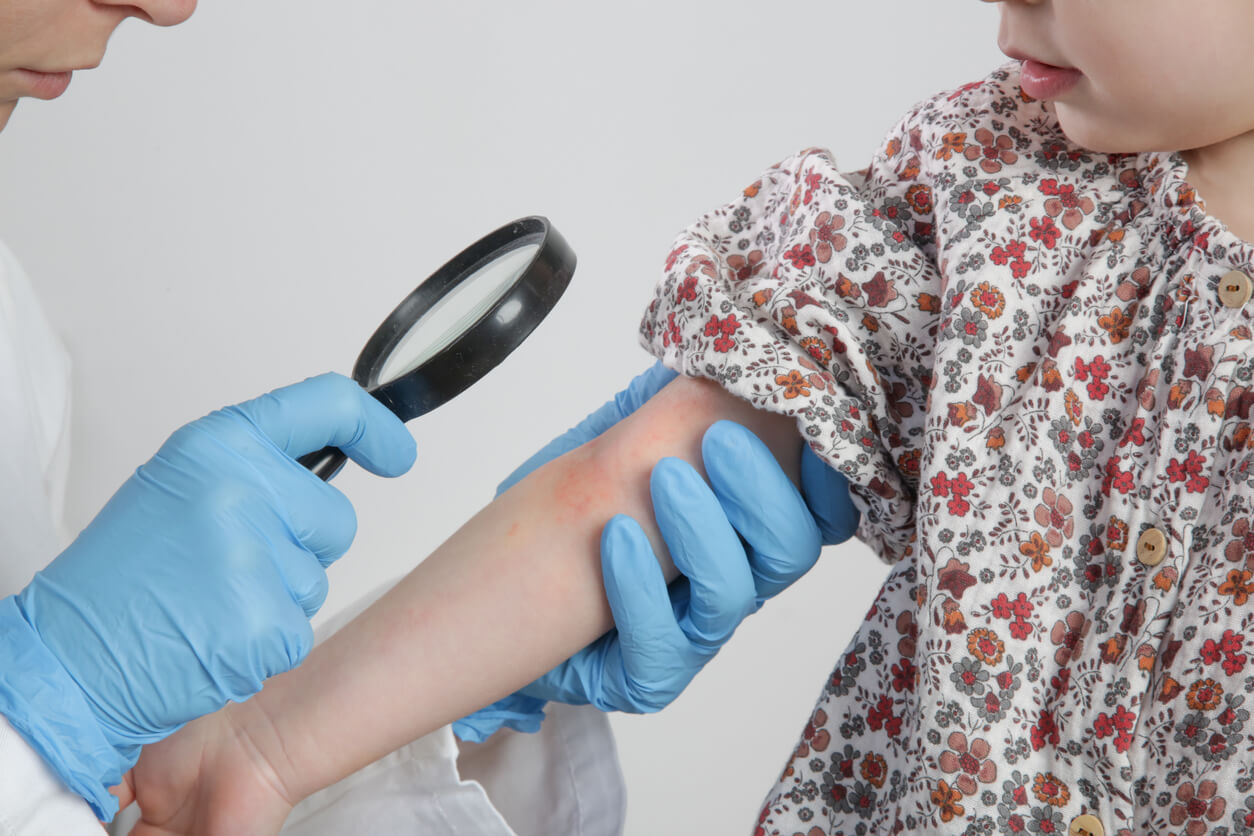10 Tips for Treating Contact Dermatitis in Children

Contact dermatitis in children is a common but underdiagnosed condition. It is an exaggerated reaction of the skin to the stimulus caused by certain substances when they touch its surface.
Although eliminating the triggering factor is the main strategy to avoid it, there are other recommendations to better manage this condition. Are you interested? In the following article, we’ll tell you all about it.
What is contact dermatitis?
As we mentioned before, this type of dermatitis starts when the skin comes into contact with certain chemicals or natural products to which it is sensitive. Most of the time these reactions aren’t usually serious, but they can be uncomfortable and unpleasant due to the intense itching they produce.
The symptoms and signs of contact dermatitis depend on the cause and the child’s sensitivity to the substance. According to a publication of the American Academy of Dermatology Association, the main manifestations are as follows:
- Redness of the skin (erythema)
- Dry or scaly skin
- Intense itching
- Cracking of the skin surface
There are three types of contact dermatitis: allergic, irritant contact, and photocontact. However, the latter is one of the least common.

Tips for treating contact dermatitis in children
Most cases of contact dermatitis usually clear up on their own once the skin is moved away from the irritating substance. However, there are some recommendations that you can implement in the event that symptoms and signs perpetuate.
1. Avoid scratching
The American College of Allergy, Asthma & Immunology recommends avoiding scratching irritated and injured skin, as it could make the situation worse. Either with further irritation or with an added infection on the skin surface requiring antibiotic treatment.
In addition, chronic scratching can cause even more itching due to the release of histamine, which is a substance that increases in the context of inflammation.
You might be interested in: 10 Types of Dermatitis in Children
2. Eliminate the triggering factor
You should stop using the product that causes the skin condition or move away from the substance that produces the symptoms.
In fact, in sensitive skin, it’s advisable to do a spot test on an exposed area of the skin each time a new product is to be used.
3. Apply topical antihistamines
One of the effective measures to reduce itching is the application of soothing lotions containing calamine or low potency glucocorticoids, such as hydrocortisone. In case the clinical picture isn’t relieved, the physician may prescribe stronger steroid creams.
Moisturizing the skin with emollients also helps to reduce dryness and itching of irritated skin.
4. Consider oral antihistamines
Sometimes the proposed hygiene measures aren’t enough to reduce itching and oral antihistamines, such as diphenhydramine or cetirizine, are required.
Systemic steroids are reserved for severe cases, but should be tapered off gradually to prevent recurrences or other unwanted effects.
5. Choose appropriate clothing
Another very appropriate strategy is the choice of neutral clothing, which provides protection against irritants in the home or work environment. In this regard, clothing made of 100% cotton fibers is one of the best recommendations. In addition, garments with synthetic or aniline-dyed fabrics should be avoided.
6. Use the correct cosmetic products
Friction should be avoided when drying or washing, as well as the use of perfumes, soaps, and colorants. At the same time, when choosing hygiene products, it’s important that they’re hypoallergenic and don’t contain chemical agents capable of causing greater irritation.
Creamy or syndet soaps are ideal for maintaining the pH of the skin close to the normal levels of the skin surface.
Read also: Natural Remedies for Atopic Dermatitis in Babies and Children
7. Include immunomodulatory drugs where necessary
Tacrolimus ointment and pimecrolimus cream are immune system response regulating drugs that are quite useful in the treatment of contact dermatitis.
Both drugs are topical and provide the same dermatologic benefits as corticosteroids, but without causing their adverse effects.
8. Moisturize the skin every day
Moisturizing is one of the most important pillars of skincare in order to keep it always functional and healthy. It’s advisable to opt for creams containing vitamin E, vitamin A, shea butter, and allantoin, among other components.

9. Use topical or oral antibiotics
Sometimes contact dermatitis evolves into more severe forms. For example, with infections on already existing lesions. Therefore, on these occasions, the use of oral or topical antibiotics is a necessary strategy.
10. Apply cold compresses
Applying cold, wet compresses several times a day to the lesion areas can help relieve irritation and itching. Moistening a soft cloth with cold water and placing it for a few minutes is sufficient.
Contact dermatitis and its evolution
Although most of the time, contact dermatitis isn’t a cause for concern, it should be treated quickly to avoid an unfavorable evolution.
However, the prognosis of the disease ultimately depends on the cause and the lifestyle of each person. Even in isolated cases, it resolves when exposure to the triggering agent is discontinued.
Contact dermatitis in children is a common but underdiagnosed condition. It is an exaggerated reaction of the skin to the stimulus caused by certain substances when they touch its surface.
Although eliminating the triggering factor is the main strategy to avoid it, there are other recommendations to better manage this condition. Are you interested? In the following article, we’ll tell you all about it.
What is contact dermatitis?
As we mentioned before, this type of dermatitis starts when the skin comes into contact with certain chemicals or natural products to which it is sensitive. Most of the time these reactions aren’t usually serious, but they can be uncomfortable and unpleasant due to the intense itching they produce.
The symptoms and signs of contact dermatitis depend on the cause and the child’s sensitivity to the substance. According to a publication of the American Academy of Dermatology Association, the main manifestations are as follows:
- Redness of the skin (erythema)
- Dry or scaly skin
- Intense itching
- Cracking of the skin surface
There are three types of contact dermatitis: allergic, irritant contact, and photocontact. However, the latter is one of the least common.

Tips for treating contact dermatitis in children
Most cases of contact dermatitis usually clear up on their own once the skin is moved away from the irritating substance. However, there are some recommendations that you can implement in the event that symptoms and signs perpetuate.
1. Avoid scratching
The American College of Allergy, Asthma & Immunology recommends avoiding scratching irritated and injured skin, as it could make the situation worse. Either with further irritation or with an added infection on the skin surface requiring antibiotic treatment.
In addition, chronic scratching can cause even more itching due to the release of histamine, which is a substance that increases in the context of inflammation.
You might be interested in: 10 Types of Dermatitis in Children
2. Eliminate the triggering factor
You should stop using the product that causes the skin condition or move away from the substance that produces the symptoms.
In fact, in sensitive skin, it’s advisable to do a spot test on an exposed area of the skin each time a new product is to be used.
3. Apply topical antihistamines
One of the effective measures to reduce itching is the application of soothing lotions containing calamine or low potency glucocorticoids, such as hydrocortisone. In case the clinical picture isn’t relieved, the physician may prescribe stronger steroid creams.
Moisturizing the skin with emollients also helps to reduce dryness and itching of irritated skin.
4. Consider oral antihistamines
Sometimes the proposed hygiene measures aren’t enough to reduce itching and oral antihistamines, such as diphenhydramine or cetirizine, are required.
Systemic steroids are reserved for severe cases, but should be tapered off gradually to prevent recurrences or other unwanted effects.
5. Choose appropriate clothing
Another very appropriate strategy is the choice of neutral clothing, which provides protection against irritants in the home or work environment. In this regard, clothing made of 100% cotton fibers is one of the best recommendations. In addition, garments with synthetic or aniline-dyed fabrics should be avoided.
6. Use the correct cosmetic products
Friction should be avoided when drying or washing, as well as the use of perfumes, soaps, and colorants. At the same time, when choosing hygiene products, it’s important that they’re hypoallergenic and don’t contain chemical agents capable of causing greater irritation.
Creamy or syndet soaps are ideal for maintaining the pH of the skin close to the normal levels of the skin surface.
Read also: Natural Remedies for Atopic Dermatitis in Babies and Children
7. Include immunomodulatory drugs where necessary
Tacrolimus ointment and pimecrolimus cream are immune system response regulating drugs that are quite useful in the treatment of contact dermatitis.
Both drugs are topical and provide the same dermatologic benefits as corticosteroids, but without causing their adverse effects.
8. Moisturize the skin every day
Moisturizing is one of the most important pillars of skincare in order to keep it always functional and healthy. It’s advisable to opt for creams containing vitamin E, vitamin A, shea butter, and allantoin, among other components.

9. Use topical or oral antibiotics
Sometimes contact dermatitis evolves into more severe forms. For example, with infections on already existing lesions. Therefore, on these occasions, the use of oral or topical antibiotics is a necessary strategy.
10. Apply cold compresses
Applying cold, wet compresses several times a day to the lesion areas can help relieve irritation and itching. Moistening a soft cloth with cold water and placing it for a few minutes is sufficient.
Contact dermatitis and its evolution
Although most of the time, contact dermatitis isn’t a cause for concern, it should be treated quickly to avoid an unfavorable evolution.
However, the prognosis of the disease ultimately depends on the cause and the lifestyle of each person. Even in isolated cases, it resolves when exposure to the triggering agent is discontinued.
All cited sources were thoroughly reviewed by our team to ensure their quality, reliability, currency, and validity. The bibliography of this article was considered reliable and of academic or scientific accuracy.
- What is contact dermatitis? [Internet] Disponible en: https://www.aad.org/public/diseases/eczema/types/contact-dermatitis
- Contacto Dermatitis. [Internet] Disponible en: https://acaai.org/allergies/allergic-conditions/skin-allergy/contact-dermatitis/
- Litchman G, Nair PA, Atwater AR, Bhutta BS. Contact Dermatitis. 2022 Feb 9. In: StatPearls [Internet]. Treasure Island (FL): StatPearls Publishing; 2022 Jan–. PMID: 29083649.
- Scheinman PL, Vocanson M, Thyssen JP, Johansen JD, Nixon RL, Dear K, Botto NC, Morot J, Goldminz AM. Contact dermatitis. Nat Rev Dis Primers. 2021 May 27;7(1):38. doi: 10.1038/s41572-021-00271-4. PMID: 34045488.
This text is provided for informational purposes only and does not replace consultation with a professional. If in doubt, consult your specialist.








